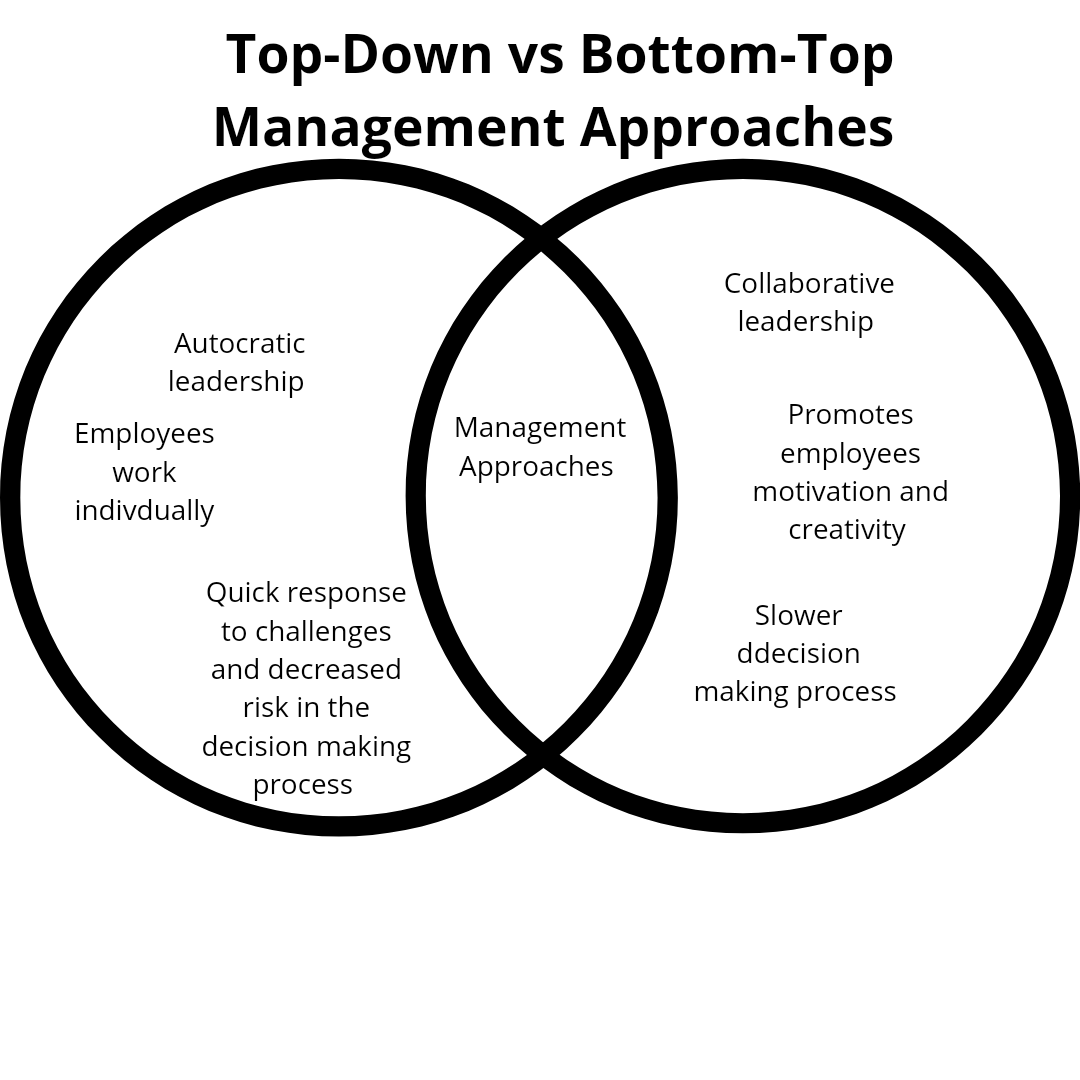It’s crucial for every manager to adopt a management style that will yield the best possible results for the organization’s goals and objectives.
There are predominantly two types of management approaches. The top-down and bottom-up management styles. There is a general consensus that none is better than the other. Each has its own benefits and downsides. The choice, however, will depend on many factors such as an organisation‘s vision, goals, culture and perspectives. Furthermore, every organization is distinct and can chart its own path to success with whatever management approach they employ.
Below, we discuss the two types of management approaches, examples and which one could be right for you.
Key Takeaways
- There are two major types of management styles organisations employ to achieve their goals. They are top-down and bottom-top management approaches.
- None is better than the other. The choice of either management approaches is dependent on many factors including an organisational culture, structure and vision.
- Apple is one organisation that employs the top-down management style while Google uses the bottom-top management approach.
- In recent times, organisations are beginning to embrace the mix of both management styles in driving productivity in their organisations.
What is Top-Down Management?
Many organisations adopt top-down management as a typical management approach. It is a dictatorial leadership style. In this setting, the organization is organized in a hierarchical manner. The implication is that the boss or a group of top leaders makes all the decisions, which are then carried out by lower-level staff or employees at the bottom of the hierarchy.
The top-down approach has the following advantages and disadvantages.
Advantages
- Quick decision making
- Employees have very clear expectations of their contribution.
Disadvantages
- Does not encourage creativity.
- Employees are micromanaged and therefore lack autonomy.
- Employees may become disconnected from the organisation‘s values and mission.
Top-Down Management Approach Examples
Apple
Raghid Shreih is the Engineering Program Manager at Shopify. In an article titled “Apple vs. Google: Top-Down vs. Bottom-Up Innovation” on LinkedIn, he describes Apple as an organisation that uses the top-down management style.
“Apple follows a more traditional approach to innovation, as demonstrated with Apple’s most successful products such as the Macintosh PC, the iPod, and the iPhone. All of these products were directed and driven by the company’s top management, and in particular by Steve Jobs. The visionary innovations pushed forward by Jobs proved to be Apple’s greatest successes.”
Shreih further explains that the approach to achieving objectives in this organisational style of management is controlled and defined. The leader is involved in every aspect of the production processes.
“…beyond providing a vision, Jobs got involved in every detail of these products. From product design, features, user interface, and marketing, Jobs was involved in all aspects of each product.”
Shreih also states that Tesla’s Elon Musk is an organisational leader that adopts the top-down management approach. “Elon Musk serves as the visionary leader who drives innovation across his companies such as Tesla, SpaceX, the Boring Company, and so on.”
Other examples of organisations using the top down management style are organisations in the public health and finance industry.
Want to start achieving your goals today? Take our free course on Building Your Personal Annual Plan!
What is Bottom-Up Management?
The bottom-up approach to management is an inclusive and collaborative form of management. It is a management style in which all employees’ perspectives, ideas, and opinions are considered before a decision is reached or made. It is also known as the “seed model” because it is believed that every employee’s idea has the potential to grow into something large that will help the organizations solve it’s problems.
The bottom-up approach does not micromanage employees. Employees are allowed to take the initiative and work autonomously. Rather than dictating the processes for employees to follow, employees are empowered to use their own initiatives to solve the organization’s problems.
Advantages
- It develops employees’ morale.
- It gives all employees the chance for their voices to be heard.
- Promotes collaboration amongst workers.
Downsides
- This results in a slower decision-making process.
- Disorganisation and frustration are common occurrences that takes place with this approach.
- Employees may drift away from organizational goals to pursue personal interests
Examples of Bottom-Top Management
In his article, Shreih pinpoints Google as a company that uses a bottom-up management strategy. To buttress this fact, Shreigh quoted “autonomy of thought to almost everything we do at Google” and “if you hire the right people and have big enough dreams, you’ll usually get there” from the forward of the book titled “How Google Work” written by Google’s co-founder and former CEO Larry Page.
“Google’s bottom-up approach has delivered a plethora of innovative products spread across many product types.” writes Shreigh.
“This has allowed Google to expand from its original focus on Search and Advertising to become a leader in mobile devices (Android), computing (Chromebooks), voice assistants (Google Home), cloud computing (Google Cloud Platform), and self-driving cars (Waymo), among many others.”
Other examples of organizations that practice bottom-up management include start-ups and media organisations.
Top-Down vs. Bottom-Top Management: Which Style is Right For You?
Management experts agree that no one style of management is better than the other. Again, from the examples of Apple and Google, Shreih states that “…one cannot say that either the Apple( top-down) or Google(bottom-top) approach is better. Rather, each approach has advantages and disadvantages.”
Furthermore, he states that “There is no single, right answer. Lessons can be learned from both Apple and Google’s approaches”.
So, the way you manage your team may depend on the structure and culture of the company, as well as other things.
It is important to note that the top-down management approach is usually suited for larger organisations. Smaller organisations may adopt the bottom-top approach. This will give room for everyone in the organization to have a voice. Which is a typical characteristic of the bottom-top approach. Waiting for input from employees in a larger organization will slow down progress and create disorganization. As such, it may not be appropriate for larger organizations.
Also, examining your organization’s culture to determine which management style will be more appropriate necessitates asking questions like:
- Do employees prefer to work individually or collaboratively?
- Are employees taking ownership of the organization’s vision and goals?
A collaborative culture will be more suited to a bottom-up management style. Organisations where employees prefer to work individually will be more productive under a top-bottom management approach.
In addition, when you look at organizational structure, things to think about are how many people work for the organisation and how many people report to each leader or manager.
Where the numbers are very large, a top-bottom approach may be more suitable.
Can I Use a Mix of Both Management Styles?
Companies like the New York Times, Ernst &Young, IBM who are top-management organisations have used a “bottom-top” approach, but not in their entire administration, writes William Maslam, a contributor for projectmanagement.com. Instead, he said the approach has been used by teams and in projects.
“As these experiments prove fruitful, more companies will come on board and even adopt the style for their full administration,” Maslam concludes.
Furthermore, research reveals that more organisations are seeking ways to use a mix of both management approaches.
So, after evaluating your organization in terms of its structure, culture, and other factors, you will be in a better position to determine if a mix of the management approaches or the use of one of them will be beneficial for your organization.

